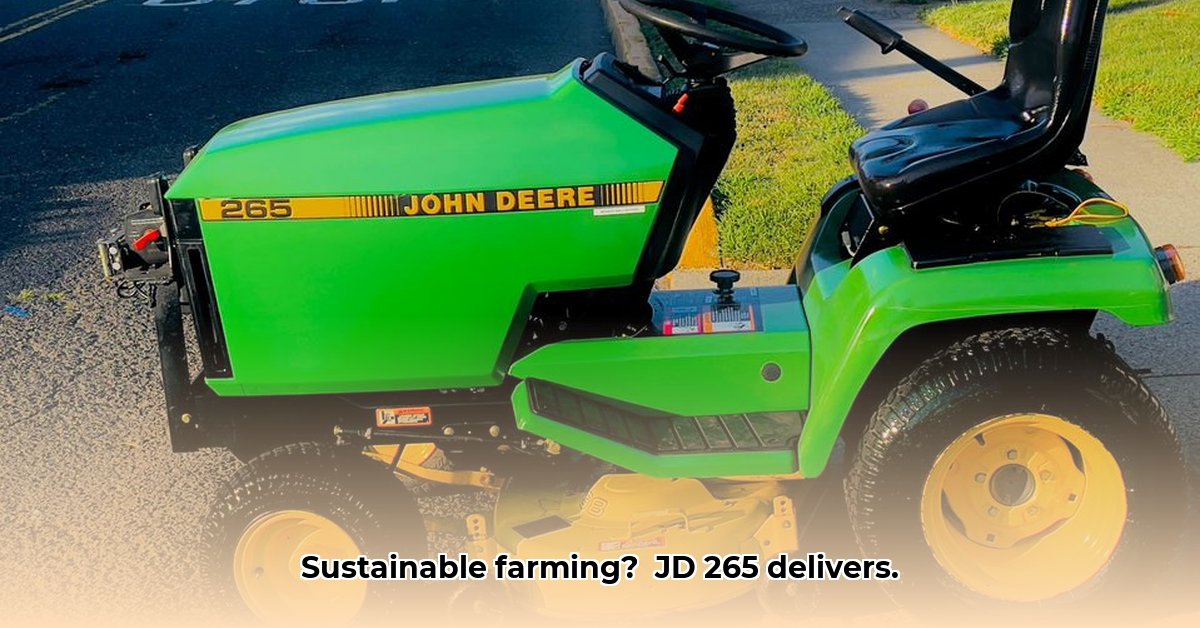
The JD 265 lawn tractor, a stalwart of the late 1980s and early 1990s, offers a compelling case study in agricultural technology evolution and sustainability. This review examines its features, performance, and environmental impact within the context of modern lawn care equipment. We'll explore its strengths and limitations, offering insights for current owners and those curious about this iconic machine. For more information on maintaining older equipment, check out these helpful resources.
A Closer Look at the JD 265: Design and Capabilities
Imagine the landscape of 1988: yards needed tending, and the JD 265, with its 17-horsepower Kawasaki gasoline engine, stepped up to the plate. Its hydrostatic transmission (a system that uses hydraulic fluid to control speed and direction) provided a smooth, user-friendly driving experience—a significant upgrade from many contemporaries. The 46-inch cutting deck allowed for efficient mowing of sizable lawns. Its versatility was further enhanced by the availability of attachments like snow blowers and tillers, extending its utility beyond the mowing season. But how does it stack up against modern standards?
Performance and Fuel Efficiency: A Historical Perspective
While the JD 265 was a robust machine for its time, its performance pales in comparison to modern tractors. Its smaller engine limits its suitability for extensive properties or challenging terrain. More significantly, its fuel efficiency is noticeably lower than that of contemporary tractors. This directly relates to crucial sustainability considerations. Why is fuel efficiency a critical factor in sustainable agriculture? Because reduced fuel consumption directly translates to lower greenhouse gas emissions and reduced operational costs.
Sustainability: Assessing the JD 265's Environmental Impact
The JD 265's primary environmental drawback is its reliance on gasoline. While efficient for its era, its fuel consumption is considerably higher than that of modern, fuel-injected tractors. These modern equivalents frequently boast improved fuel efficiency and significantly reduced emissions. The advancement to biofuels in some modern tractors further highlights the progress in sustainable agricultural practices. Could you convert a JD 265 to biofuels? Potentially, but it would require substantial modification and research. The disposal of used engine oil and components also presents a modern-day environmental challenge, with stringent regulations requiring responsible disposal practices that were less stringent during the tractor's operational lifespan.
JD 265 vs. Modern Tractors: A Comparative Analysis
Here’s a direct comparison highlighting the advancements in sustainable agricultural technology:
| Feature | JD 265 | Modern Sustainable Tractors |
|---|---|---|
| Engine | 17 HP Kawasaki, Gasoline | Varied, often lower HP with higher fuel efficiency |
| Transmission | Hydrostatic | Hydrostatic or CVT (Continuously Variable Transmission) |
| Fuel Efficiency | Relatively low | Significantly higher |
| Emissions | Higher compared to modern equivalents | Significantly lower |
| Technology | Basic | Advanced (GPS guidance, precision spraying, etc.) |
The table clearly illustrates the significant leap in fuel efficiency and reduced emissions achieved by modern tractors. Advanced features like GPS-guided operation contribute to minimizing fuel waste and resources, ultimately resulting in greater efficiency and cost savings.
Maximizing Efficiency and Minimizing Environmental Impact with Your JD 265
Even if you own a JD 265, you can still take steps to reduce its environmental impact. Following these steps can extend the life of your machine and promote responsible resource management.
Prioritize Preventative Maintenance: Regular maintenance—including oil changes, filter replacements, and fuel system checks—is essential for optimal engine performance and fuel efficiency. This simple practice reduces fuel consumption and extends your tractor's lifespan.
Explore Biofuel Conversion (Cautiously): Converting older equipment to biofuels often requires extensive modifications and should only be undertaken after thorough research and with qualified assistance. Improper conversion could damage the engine.
Responsible Disposal: When the time comes to retire your JD 265, ensure the responsible disposal of used oil and components in accordance with local environmental regulations to prevent further environmental harm.
Conclusion: A Legacy of Innovation and the Path to Sustainability
The JD 265 stands as a testament to the evolution of agricultural machinery. While its fuel efficiency and technological sophistication are surpassed by modern equivalents, its simplicity and reliability continue to have value. The JD 265's legacy serves as a powerful reminder of advancements in sustainability across the agricultural sector, underscoring the importance of continuous innovation for a greener future. Modern tractors are more fuel-efficient and environmentally friendly due to technological advancements and a stronger emphasis on sustainable practices within the industry.